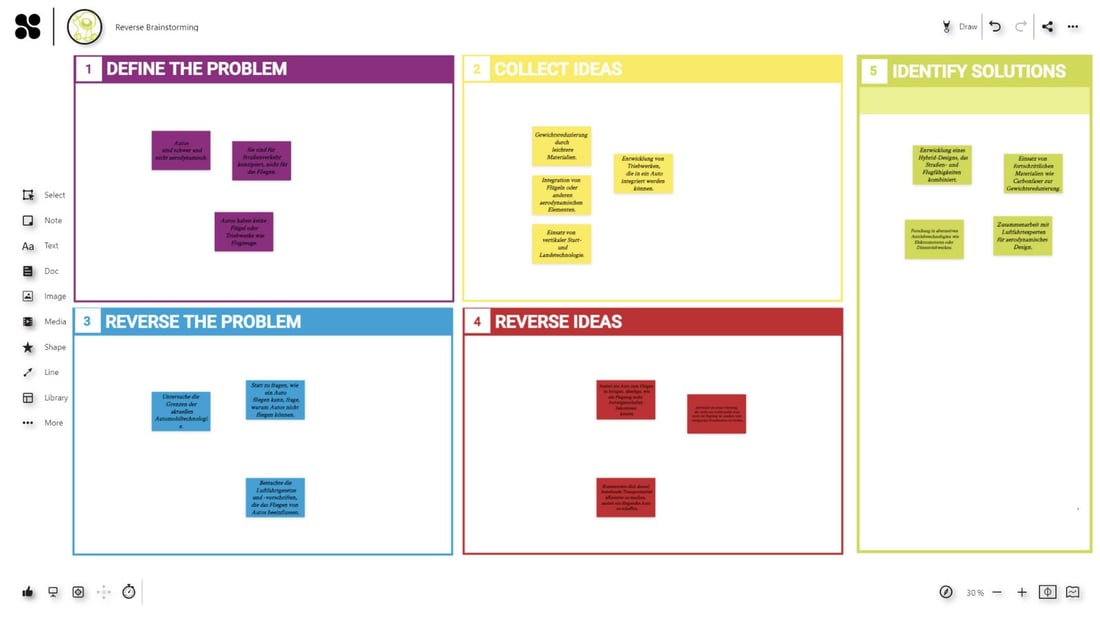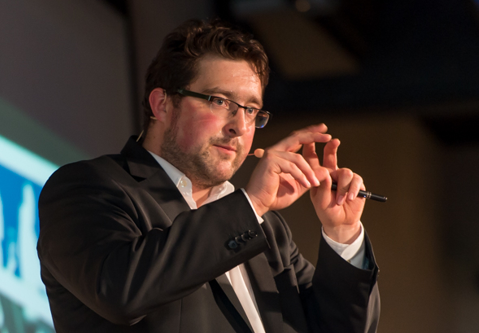Today we would like to introduce you to the method of reverse brainstorming.
In this article, we will examine reverse brainstorming and its advantages. We will also provide examples of how to use this method and help you solve common challenges. Finally, we will give you tips on how to implement a successful reverse brainstorming session.
What is Brainstorming?
To begin with, we would like to briefly explain what brainstorming actually is.
The term "brainstorming" refers to various methods for finding ideas. The special thing about brainstorming is that all participants can share their ideas and all ideas are collected. The ideas are simply noted down and not evaluated. The ideas are only evaluated and sorted after the brainstorming session.
Reverse Brainstorming - Definition
Reverse brainstorming is sometimes also referred to as "negative brainstorming". It is a process that turns typical brainstorming on its head.
Instead of asking participants to come up with ideas to achieve a goal or make improvements, the exact opposite is done. Participants are asked to find ways to make it impossible to achieve the goal. In this way, pent-up negative thoughts come to the surface, and you receive important information about what is not working.
Once you know what is not working, you can plan for success.
Why Reverse Brainstorming?
Creativity is the fuel for innovative solutions and traditional brainstorming undoubtedly has its advantages. However, sometimes traditional approaches reach their limits and require new ways of thinking.
In classic brainstorming, the focus is on generating ideas. Participants express their thoughts spontaneously and the ideas are later reviewed and evaluated. However, this approach can lead to certain limitations. A few loud voices often dominate, while other reserved voices are ignored. In addition, the focus on solutions can lead to critical aspects being overlooked.

Reverse Brainstorming Template in Collaboard
A new look at creative challenges
This is where reverse brainstorming comes in by reversing the perspective. Instead of looking for solutions, the participants start by analyzing the problem. This enables a fresh approach that focuses on obstacles and difficulties. By questioning assumptions and uncovering challenges, a new dynamic is created. This new dynamic also gives rise to unconventional and innovative solutions. With reverse brainstorming, the creative process is viewed from a different angle.
The Basics of Reverse Brainstorming
Reverse brainstorming poses the question: "How can we exacerbate or worsen this problem?"
By consciously looking for negative influences, an environment is created in which the participants intensively deal with the challenges.
The best way to visualize the process of reverse brainstorming is to compare it to typical brainstorming:
|
Typical brainstorming |
Reverse Brainstorming |
|
How can we improve this product? |
What could we do so badly that nobody buys this product anymore? |
|
How do we ensure that this project is a success? |
How is this project guaranteed to be a failure? |
|
How can we improve our customer service? |
How can we make customer service so bad that everyone goes to the competition? |
This reversal of focus encourages the discovery of new perspectives and allows for the development of innovative solutions that might have been overlooked in conventional brainstorming.
Use Cases for Reverse Brainstorming
Companies looking for innovative ways to boost their creativity are successfully using reverse brainstorming. The aim here is to break through traditional thought patterns and generate innovative ideas. This can take place in workshops or team meetings, for example, in which employees examine challenges together.
Possible use cases are:
-
Customer-oriented innovationCompanies use reverse brainstorming to better understand customer needs. By highlighting potential frustrations or negative customer experiences, innovative solutions can be developed that increase customer satisfaction.
-
Problem-solving in teamsTeams facing difficult decisions use reverse brainstorming to uncover all potential hurdles. This encourages the open exchange of ideas and enables sound solution strategies to be developed.
-
Product optimization during developmentDuring the product development phase, reverse brainstorming can be used to identify weak points and potential problems at an early stage. This enables targeted optimization before the product is launched on the market
Thinking Together - Reverse Brainstorming in a Team
The reverse brainstorming method proves to be extremely effective, especially in teamwork.
There are different perspectives and areas of expertise in a team. Reverse brainstorming encourages the use of this diversity. Each team member brings their individual perspective to the problem, resulting in a wide range of ideas. The diversity of views not only encourages creativity but also allows different aspects of the problem to be considered. In addition, the joint thought process enables an interactive exchange.
Challenges and Solutions in Group Work
Let's take a look at possible challenges in group work and their solutions:
- Overcoming inhibitions: In group situations, there can be inhibitions about expressing ideas that are unconventional or perceived as "different". Here it is important to create an open and supportive atmosphere that encourages creativity. Team leaders can help overcome inhibitions by providing positive reinforcement and emphasizing the importance of different perspectives.
- Clear communication: One of the challenges of group work is clear communication. It is crucial to ensure that everyone in the team understands the problem and the ideas generated in the same way. Clear structures and the use of visual aids can help to minimize misunderstandings and increase effectiveness.
- Lack of participation: Not every team member may actively participate in brainstorming. Introducing clear roles and responsibilities and emphasizing the importance of each individual contribution can help to increase participation.
- Time management: In group work, there is a risk of time being wasted due to discussions getting out of hand or an unclear agenda. Effective time management, clear structures and setting time limits for certain phases of reverse brainstorming can help to make efficient use of time.
Tips for Successful Reverse Brainstorming
Reverse brainstorming is a powerful method, but it requires a certain approach to achieve optimal results.
The right approach: Structured vs. Creative
Reverse brainstorming works according to the motto: think in a structured way, act creatively.
Start by clearly defining the problem. Structure the analysis by highlighting the negative aspects. Do not limit yourself too early in your considerations; encourage your team to express unconventional ideas. A good balance between structure and creativity promotes an effective reverse brainstorming process.
How to keep the flow of ideas going
- Encourage open communication
Create an environment in which team members can talk openly about potential problems. An atmosphere of trust encourages the exchange of ideas and helps to shed light on all aspects of the problem. - Focus on the problem
Make sure that the discussion stays focused on the problem to be solved. It's easy to dive into the flow of ideas, but it's important to make sure that each idea pays into the core problem. - Encourage divergent thinking
Encourage your team to think outside the box. The first step is to generate as many ideas as possible, regardless of their feasibility or relevance. Divergent, unconventional thinking promotes the diversity of ideas and enables new approaches. - Prioritize ideas
Once a large number of ideas have been collected, it is important to sharpen the focus. Prioritize the ideas according to their relevance and feasibility. This will allow you to concentrate on the most promising solutions. - Gather feedback
Conclude the reverse brainstorming process with a feedback round. Let your team members express their thoughts and concerns about the ideas collected. This will promote continuous improvement and strengthen teamwork.
Reverse Brainstorming - Frequently Asked Questions & Answers
Why should I use reverse brainstorming?
Reverse brainstorming enables a change of perspective in which problems are approached from their root cause. This promotes innovative solutions and prevents adherence to conventional thought patterns.
How does reverse brainstorming work compared to traditional brainstorming?
In contrast to the traditional approach of collecting ideas, reverse brainstorming focuses on identifying problems and transforming them into positive, solution-oriented approaches.
When is the best time for reverse brainstorming?
Reverse brainstorming is particularly effective when teams reach an impasse or realize that conventional solutions are not working. It can also be used preventively to identify potential problems in advance.
How do I carry out a successful reverse brainstorming session in a team?
Successful reverse brainstorming requires an open, collaborative environment. Focused problem definition, clear communication and a willingness to challenge conventional ways of thinking are crucial.
Can reverse brainstorming be carried out alone?
Yes, reverse brainstorming can also be used individually. In this case, it is important to consciously alternate between identifying problems and developing positive approaches.
What role does problem analysis play in reverse brainstorming?
Problem analysis is the starting point for reverse brainstorming. Through a thorough analysis, the problem is understood before it is transformed into positive approaches.
How can I ensure that my reverse brainstorming remains creative?
The right mix of structure and creativity is crucial. Clear approaches and framework conditions promote creativity while maintaining a focus on innovative solutions.
Are there industries in which reverse brainstorming is particularly effective?
Reverse brainstorming can be used across all industries and is particularly effective in situations where fresh perspectives are needed, be it in product development, marketing, or the problem-solving process.
Can reverse brainstorming also be used for existing ideas?
Yes, reverse brainstorming can also be used to improve or further develop existing ideas. It is a flexible tool that can be applied to different scenarios.
Are online whiteboards suitable for reverse brainstorming?
An online whiteboard, or digital whiteboard, is very suitable for implementing the reverse brainstorming method. On the whiteboard, everyone can record ideas, questions and thoughts on cards in real time.



